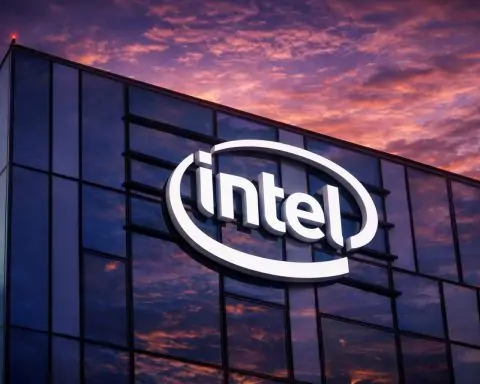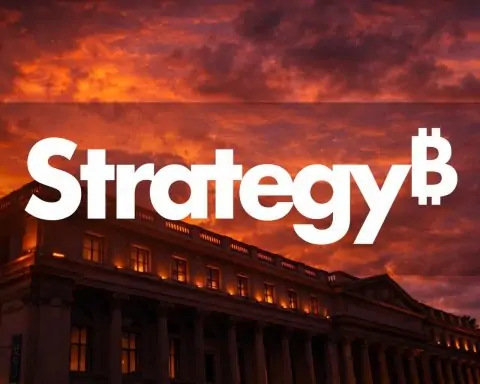- Bitcoin traded around $115,000–$117,000 over Aug. 24–25, 2025, roughly four times its level a year earlier and well above its 2021 all-time high of $69,000.
- Ethereum neared $4,800 and briefly hit about $4,870 on Aug. 24, 2025, approaching its record and signaling strong institutional demand.
- Aave deployed its v3 on the Aptos blockchain on Aug. 21, 2025, marking its first expansion beyond Ethereum, with the AAVE token rising about 19% to around $355.
- The U.S. Senate passed the GENIUS Act 68–30 in June 2025 to set federal standards for stablecoins, and the CLARITY Act advanced over Aug. 24–25 to unify crypto regulation for banks and custodians.
- SBI Holdings and Chainlink announced a strategic partnership to tokenize real-world assets and develop regulated stablecoins using CCIP, building on the Singapore Project Guardian pilot.
- Mastercard, Ripple, and Gemini announced the Gemini XRP Mastercard, issued by WebBank, offering 4% cashback in XRP and backed by a $75 million pool for adoption with pilots in Thailand.
- SoFi Technologies will launch a Lightning Network remittance service later in 2025, initially for the US-to-Mexico corridor, routing dollars through BTC via Lightspark and the UMA protocol.
- Pudgy Penguins briefly overtook BAYC in NFT market cap around Aug. 21, 2025, with total value about $491M versus BAYC’s $482M, and BTCS Inc. added three Pudgy Penguin NFTs to its treasury.
- A $91.4 million Bitcoin social-engineering theft occurred on Aug. 19, 2025, after a hacker impersonated hardware-wallet support and coerced seed phrase disclosure.
- Hut 8 announced plans to raise up to $1 billion via a shelf offering, while building a $2.5 billion AI-driven data center in Louisiana.
Crypto markets sizzled over the weekend as Bitcoin flirted with record prices while policymakers worldwide raced to integrate digital assets into traditional finance. Major DeFi protocols hit new milestones, NFT trading sprang back to life, Fortune 500 banks launched blockchain projects, and even hackers seized the moment amid the rally. Below we break down all the top blockchain developments from August 24–25, 2025 – from global regulatory shakeups and surging crypto prices to DeFi innovations, NFT revivals, enterprise adoption wins, security scares, and high-profile partnerships/fundings – with expert insights and primary sources throughout.
Crypto Market Soars: Bitcoin & Ether Near Peaks, Altcoins Ride the Wave
Bitcoin (BTC) pushed into uncharted territory this weekend, trading around $115,000–$117,000 – more than quadruple its price a year ago and well past its previous $69K all-time high from 2021 [1]. Ethereum (ETH) wasn’t far behind: it neared $4,800 (just shy of its ~$4,870 record), reflecting “strong investor demand amid growing institutional adoption,” CoinDesk noted [2]. In fact, Ether briefly hit ~$4,870 on some exchanges on Aug. 24 – effectively a new high – before slight profit-taking [3] [4]. With the two largest cryptocurrencies in “rarefied air,” analysts are once again dusting off sky-high targets. Fundstrat’s Tom Lee even reiterated a $15,000 year-end target for ETH, citing its pivotal role in DeFi, stablecoins and real-world asset tokenization [5]. Others see BTC marching to $140K+ if current trends hold, especially with multiple spot Bitcoin ETF applications pending approval.
What’s fueling the rally? A major catalyst was the Federal Reserve’s dovish pivot at Jackson Hole on Aug. 22. Fed Chair Jerome Powell struck an unexpectedly accommodative tone, suggesting inflation is largely tamed and rate cuts are likely imminent. CME futures quickly priced in an 83% chance of a Fed rate cut in September (up from 75% prior) [6]. This “Powell pump” ignited risk assets across the board, and crypto was no exception. Institutional investors poured in on expectations of easier monetary policy weakening the dollar. “Asset managers [say] they expect Bitcoin to see a ‘new high’ and Ether to ‘top $5K’ thanks to the Fed’s stance and rising ETF inflows,” CoinDesk reported [7] [8]. Indeed, anticipation of U.S.-listed spot crypto ETFs has already unleashed a wave of FOMO. Over $12.7 billion flowed into U.S. spot Ether ETFs in August alone, making ETH ETFs the surprise hit of 2025 and adding significant liquidity to the market [9].
Another spark came from regulatory news (paradoxically, bad news turning good). The U.S. SEC recently lost a high-profile court case, paving the way for Grayscale’s huge Bitcoin Trust to convert into an ETF – seen as a de facto win for investors. Meanwhile, titans BlackRock and Fidelity updated their Bitcoin ETF filings, a move one analyst called a “very good sign” for eventual approval [10]. All these developments have boosted market confidence and “brought a wave of institutional FOMO,” further feeding the bullish cycle [11].
Altcoins enthusiastically joined the party.XRP (Ripple’s token) skyrocketed to about $3.10 on Aug. 23 – its highest price in over 5 years – before a modest pullback [12]. XRP jumped ~8.5% in one day amid a five-fold surge in trading volumes following the Fed news and renewed on-chain activity on XRP Ledger [13]. Notably, “on-chain settlement volumes…surged 500%, indicating potential institutional adoption,” CoinDesk observed, even as traders watch if $3.00 can hold as new support [14]. Other majors saw similar spikes: Solana (SOL) and Dogecoin (DOGE) each popped double-digits. DOGE broke out of a months-long range with an ~11% jump, which some attributed to hype around an upcoming SpaceX satellite launch nicknamed after Doge (Elon Musk’s memes still echo in these markets). DeFi tokens also rode the wave – as discussed below, Aave jumped nearly 20% – and even the beleaguered FTX Token (FTT) saw a speculative bump on rumors of asset recovery efforts [15]. In short, “altcoin season” vibes are creeping back (albeit selectively) after a long hiatus.
The frenzy wasn’t without drama. Derivatives markets experienced whipsaw liquidations as volatility spiked. Over $400 million in ETH futures positions were liquidated in 24 hours – an unusually high number [16]. Early in the rally, it was mostly shorts getting squeezed (forced to buy back as ETH ripped higher), but near the top, even overeager longs got wiped out when ETH dipped off intraday highs [17]. The lesson: even in a bull run, risk management is key – sharp moves can punish excess leverage on both sides.
Outlook: Sentiment is the most bullish it’s been in years, though some debate if a short-term cooldown is due. On one hand, “We’re in a regime of positive news and catalysts, so dips are shallow,” observed one fund manager [18]. On the other, contrarians note that BTC at ~$115K (and ETH near $5K) represent huge year-to-date gains – some consolidation or profit-taking would be natural. Key events loom: the SEC’s ETF decision deadlines in the fall, and the Fed’s September meeting. A surprise ETF approval or an actual rate cut could fuel another leg up; conversely, any delay or hawkish signal might trigger a pullback [19]. But for now, “don’t try to short a market with this much strength. Until proven otherwise, the bulls are in control,” veteran analyst Michaël van de Poppe quipped [20].
Regulatory Shakeups: New Laws and Policies Reshaping Crypto’s Future
It was a banner period for crypto regulation across multiple continents, as lawmakers rolled out rules that promise to fundamentally alter the industry’s trajectory. In Washington, D.C., landmark legislation is advancing on several fronts. The U.S. Senate over the summer passed the GENIUS Act, a comprehensive framework for stablecoins (formally the “Stablecoin Transparency and Security Act”). This bill – which passed the Senate 68-30 in June [21] and cleared the House in late July – establishes, for the first time, clear federal standards for U.S. dollar-pegged stablecoins. It requires issuers to fully back tokens with high-quality liquid assets (like cash or T-bills) and mandates monthly reserve disclosures [22]. “It is a major milestone,” said former White House advisor Andrew Olmem, noting how rapidly the stablecoin market has grown in importance [23]. The crypto industry has long clamored for such clarity, arguing it will unlock wider adoption of stablecoins in payments [24]. The GENIUS Act’s swift passage “caught many in Europe off guard,” according to the Financial Times [25] [26]. EU officials had expected Europe to lead on crypto rules, but suddenly the U.S. leapfrogged – potentially giving dollar-backed stablecoins a major edge globally. European regulators are now racing to respond, fearing that “dollar-backed stablecoins could tighten America’s grip on cross-border payments if the EU doesn’t accelerate its own plans” [27].
Meanwhile, just this weekend the U.S. Senate advanced the CLARITY Act – another pillar of the regulatory push. Officially the “Crypto Law and Accountability for Risks, Innovation, and Technology (CLARITY) Act,” the bill aims to establish a unified legal framework for digital assets, especially for banks and custodians [28]. Senator Cynthia Lummis, who spearheaded the effort, explained that CLARITY will serve as the baseline for U.S. crypto regulation, with Senate Banking and Agriculture Committees working to combine their proposals into one comprehensive law by year-end [29]. A key focus is giving traditional financial institutions the green light to custody crypto safely. The Act spells out rigorous requirements for secure key management and institutional accountability when banks handle crypto assets – addressing the legal ambiguity that has long kept big banks on the sidelines [30]. By reducing uncertainty, lawmakers hope to encourage more banks to offer crypto services, increasing market legitimacy. The bill also projects ~$600 million in tax revenue from clarifying crypto tax treatment, and it tightens anti-money-laundering compliance under the Bank Secrecy Act [31]. Not everyone is thrilled, though. Crypto skeptic Senator Elizabeth Warren warned the CLARITY Act could “blow up the U.S. economy” by over-legitimizing crypto, reflecting partisan tensions in the debate [32]. Notably, the House’s version of broad crypto legislation (the aforementioned GENIUS Act on stablecoins) will need to be reconciled with CLARITY – so the coming months will involve intense negotiation on Capitol Hill [33]. Still, the momentum in Congress marks a sea change: after years of gridlock, clear U.S. crypto laws are finally coming into view.
Across the Atlantic, Europe is scrambling to keep up. The EU’s comprehensive crypto framework (MiCA) is set to take effect in 2024, but U.S. moves on stablecoins have added urgency to EU plans for a digital euro. In an unexpected twist, European central bankers are now considering launching a CBDC on public blockchain rails like Ethereum or Solana, rather than a closed system [34]. Until recently, the European Central Bank favored a permissioned approach for its digital euro, citing control and privacy [35]. But insiders say the U.S. stablecoin law “shifted the conversation” – officials are now open to leveraging decentralized networks so a euro stablecoin could “circulate more freely” and compete with dollar tokens [36] [37]. Such an idea was almost unthinkable a year ago. The pressure is on: China is piloting its digital yuan, the UK is exploring a “digital pound,” and the U.S. may soon have regulated private stablecoins dominating globally. “We can’t afford to be left behind when others’ money goes digital,” one EU lawmaker said pointedly [38]. The ECB has hinted it will decide on a digital euro’s design by end of 2025 [39]. Whether Europe truly pivots toward using public crypto networks for a CBDC remains to be seen – but the fact it’s even on the table validates blockchain tech at the highest levels of finance.
In Asia, Japan unveiled a bold regulatory overhaul aimed at making the country a crypto haven. The Financial Services Agency (FSA) announced plans to slash Japan’s crypto tax rate from up to 55% (for top earners) down to a flat 20%, aligning crypto taxation with stocks [40]. Currently, Japan’s onerous taxes (as high as 55% on gains) are blamed for driving crypto talent abroad. The proposal would also reclassify digital assets as “financial products” akin to securities [41]. This legal tweak is crucial: treating tokens like stocks/bonds puts them under the right rules to list crypto ETFs and other investment vehicles on Japanese exchanges [42]. In fact, Japan explicitly aims to approve its first domestic Bitcoin ETF once this reform passes, likely riding on U.S. ETF approvals expected by then [43]. Overall, the changes are designed to “boost Japan’s competitiveness in the global digital asset landscape,” the FSA said [44]. Prime Minister Fumio Kishida’s pro-Web3 government clearly wants to lure back crypto startups and capital that fled to Singapore and elsewhere. The flat 20% tax (with potential loss carryforwards, similar to stock rules) would put Japan among the most crypto-friendly tax regimes in major economies by 2026 [45]. Observers say it could ignite a wave of Japanese yen flowing into crypto markets [46]. Treating crypto as securities would also impose higher disclosure standards and investor protections, which could attract more institutional money over time [47]. It’s a dramatic pivot from a few years ago, when Japan’s regulators were seen as overly strict post-Mt. Gox. Now, under Kishida, Japan is vying to be East Asia’s premier crypto hub. Industry groups there welcomed the tax cut, though they’re lobbying for even more (like no tax on unrealized gains). The proposal still needs parliamentary approval, but anticipation is high it will be implemented by 2026 [48].
Elsewhere, India – home to one of the largest bases of crypto users – signaled it may finally soften its harsh stance. Officials in New Delhi hinted at revisiting the 30% crypto gains tax and 1% transaction levy that were imposed in 2022 and have since crushed local trading volumes [49]. The current regime is among the world’s most punishing, and has largely driven Indian crypto activity underground or offshore. Any relief (even a modest tax cut or removing the TDS levy) would be hugely significant given India’s population of 1.4 billion. For now it’s just talk, but the fact it’s on the table suggests policymakers recognize the downside of over-regulation – a theme playing out globally.
A few other regulatory tidbits: In the U.S., the IRS’s head of crypto enforcement, Jarrett Rees, announced his departure, just as the Treasury and IRS draft new reporting requirements for digital assets under recent laws [50]. His exit after leading crypto tax guidance hints at a “changing of the guard” before fresh rules kick in for 2026. Over at the CFTC, Acting Chair Caroline Pham (a noted crypto advocate) has been unusually proactive – launching a digital asset initiative and meeting industry players – while the agency awaits a permanent head [51]. It shows the CFTC’s urgency to better oversee crypto derivatives, especially after wild swings in Bitcoin futures and the rise of DeFi trading. And in Hong Kong, officials clarified that their coming stablecoin (HKDG) is intended solely “as a payment tool and not for speculation,” urging public caution [52]. Hong Kong’s nuanced embrace of crypto – permitting exchanges and token sales under strict oversight – continues to draw interest as a model of balanced regulation.
Big picture: After years of uncertainty, governments are finally writing the “rules of the road” for crypto, often opting to integrate the sector into the existing financial system rather than outlaw it. The flurry of stablecoin laws, tax reforms, and ETF approvals suggests major economies want crypto inside the tent (albeit under watchful eyes) rather than in the Wild West shadows. This trend means clearer guardrails – and yes, more compliance costs – but also the removal of legal gray areas that kept institutional money away. As frameworks start harmonizing across borders (e.g. the U.S. and Japan both moving toward treating crypto like traditional securities in many respects), cross-border crypto activity is likely to accelerate. To be sure, not every jurisdiction is turning friendly – the U.S. SEC is still aggressively pursuing exchanges and DeFi under old securities laws, the EU’s MiCA will impose heavy compliance by 2024, and China remains largely closed to public crypto. But compared to the regulatory vacuum of the past, late 2025’s direction is clear: crypto is getting legitimized as an asset class through formal policy. As blockchain lobbyist Perianne Boring quipped, “We’re moving from the Wild West to a regulated freeway – still open terrain, but you better follow the speed limit.” [53] [54]
DeFi Breakthroughs: Aave’s Multichain Milestone & Yield Rumors
Decentralized finance saw explosive growth and notable announcements over the weekend, illustrating both the technological maturation of DeFi and the speculative frenzy that still drives it. Aave (AAVE) – one of the largest DeFi lending protocols – led the charge. Its governance token surged ~19% in 24 hours to around $355, the biggest jump among top crypto projects [55]. Several factors fueled Aave’s stunning rally.
First, Aave achieved a major technical milestone: on August 21, it deployed Aave v3 on the Aptos blockchain, marking Aave’s first expansion beyond Ethereum and other EVM-compatible chains [56]. Developers spent months rewriting Aave’s smart contracts in Move (Aptos’s language) and rolled out on Aptos with audits and a $500k bug bounty for security [57] [58]. “An incredible milestone,” hailed Aave founder Stani Kulechov of the multichain launch, highlighting the significance of moving beyond Ethereum after five years on only EVM networks [59]. This cross-chain leap opens Aave to new users and liquidity in the Aptos ecosystem, underscoring DeFi’s growing interoperability. The Aptos Foundation’s director even called the launch a “major milestone” for the Layer-1, showing the collaboration’s importance [60]. Aave’s successful Aptos debut proved that blue-chip DeFi protocols can go cross-chain – a bullish sign for the sector’s multichain future.
Second, macroeconomic tailwinds gave DeFi a boost. As noted earlier, Fed Chair Powell’s dovish signals on Aug. 22 triggered a broad market rally. Higher-risk assets like DeFi tokens saw outsized gains. Aave was “among the biggest movers” following Powell’s remarks, CoinDesk noted [61]. With interest rate cuts looking likely, investors piled into yield-bearing DeFi platforms as a bet on renewed risk appetite. Lower rates generally weaken the appeal of dollars and bolster alternative yields, so Powell’s hint of easing acted as rocket fuel for DeFi sentiment.
Finally – in true crypto fashion – rumors and politics played a role. Over the weekend, market chatter spread that Aave might have hidden exposure to World Liberty Financial (WLFI) – a DeFi venture reportedly tied to former U.S. President Trump’s family. The speculation suggested Aave’s DAO could receive a significant allocation of WLFI tokens if that project launches. One analyst estimated Aave’s cut “could be worth around $1.9 billion — more than a third of [Aave’s] current $5B valuation” given WLFI’s rumored $27B valuation [62]. The WLFI team denied the 7% token allocation rumor as “false and fake news” [63]. Nonetheless, just the mere prospect of such an unexpected windfall may have spurred some speculative AAVE buying. It’s a reminder that even as DeFi matures, crypto markets are not above trading on unconfirmed whispers – especially when they involve high-profile names and eye-popping numbers.
The takeaway: Aave’s wild weekend encapsulated how DeFi tokens can whipsaw on real fundamentals and rumors alike. On one hand, the protocol’s multichain expansion to Aptos is a concrete advance, showing DeFi’s tech progress toward greater cross-chain liquidity. On the other, macro shifts (Fed policy) and even political intrigue can still whipsaw token prices overnight. After its spike, AAVE has held most of its gains, with traders watching whether follow-through demand materializes or if short-term players take profit [64]. Either way, the past 48 hours proved that DeFi is alive and kicking – innovating across chains and ready to ride broader market tailwinds.
Beyond Aave, other DeFi projects made quieter moves. Aave’s rival MakerDAO (MKR), for instance, quietly extended a steady uptrend – gaining ~10% on the week – as it approaches a major token supply reduction under its “Endgame” restructuring plan [65]. Maker’s forthcoming buyback and burn (part of an overhaul to make the protocol more resilient) has investors optimistic about MKR despite the lack of hype. And in a positive security story, white-hat hackers are actively safeguarding DeFi: this week Immunefi disclosed that a researcher narrowly averted a potential $50M exploit in a popular protocol, patching the vulnerability in time. Many new DeFi launches now come with audits and bug bounty programs by default (Aave’s $500K bounty for its Aptos code being one example [66]), which is a welcome sign of the industry learning from past hack crises.
NFT & Web3 Revival: Blue-Chip NFTs Resilient as Gaming and Brands Dive In
After a prolonged lull, the NFT market is flashing signs of a comeback alongside the broader crypto rally. July 2025 NFT sales volume exploded to $574 million – a 47% jump from June, marking the second-highest month of the year [67]. Average NFT sale prices also hit ~$113, a six-month peak [68], suggesting collectors are once again shelling out for higher-value digital collectibles. By late August, that momentum continued, albeit with some turbulence due to swings in Ethereum’s price.
The tight correlation between ETH and NFT values was on full display mid-month. As Ether briefly pulled back from ~$4,700 to ~$4,260 in mid-August, the total NFT market cap fell about $1.2 billion (≈12%) in under a week [69]. The sector slid from roughly $9.3B to $8.1B, showing that NFT valuations (denominated largely in ETH) still live and die by Ethereum’s price [70]. Top blue-chip collections like CryptoPunks and Bored Ape Yacht Club (BAYC) saw their U.S. dollar market caps dip ~12–20% during ETH’s swoon [71] [72]. As Cointelegraph noted, “Many NFTs are minted on Ethereum… bullish or bearish momentum in ETH often translates into NFT sector value.” In other words, when ETH fell ~9%, NFT values fell in tandem as traders recalibrated [73] [74]. The close coupling is a double-edged sword: it means NFTs will benefit if ETH continues upward, but also that NFT investors must watch macro crypto trends closely.
Yet blue-chip NFTs showed resilience – and even a changing of the guard. During the market swings, the once-whimsical Pudgy Penguins profile-picture collection climbed into the #2 spot by NFT market cap, briefly overtaking the famous BAYC [75]. By Aug. 21, Penguins’ total value hovered around $491M, edging out BAYC’s ~$482M (though both fluctuated) [76]. This passing of the torch, even if temporary, underscores shifting tastes among collectors. Pudgy Penguins, originally an underdog meme collection from 2021, has enjoyed a renaissance thanks to strong community branding and savvy expansion into toys and media. They even got corporate validation – Nasdaq-listed BTCS Inc. added three Pudgy Penguin NFTs to its corporate treasury as an investment, one of the first public companies to hold NFTs on its balance sheet [77]. Companies are “beginning to recognize blue-chip NFT collections as legitimate assets for treasury diversification,” analysts noted after BTCS’s move [78]. That kind of institutional nod is something even BAYC never saw, and it helped Penguins’ market cap surge. (The Penguins vs. Apes race remains close – a testament to how quickly fortunes can shift in NFT-land.)
Meanwhile, other corners of the NFT world flashed encouraging signs:
- Whale collectors are still active. A single CryptoPunk (#7804) reportedly sold for 4,850 ETH (≈$16 million) recently [79], one of the largest NFT sales on record. It’s a reminder that even in a thinner market, big-money buyers will splurge for the rarest grails, suggesting confidence that blue-chip NFTs hold long-term value.
- Creator royalties are making a comeback. NFT marketplace Rarible saw usage jump after it pledged to continue enforcing artist royalties on secondary sales, in contrast to market leader OpenSea’s controversial move to make royalties optional (a 2023 decision that sparked backlash). NFT die-hards rallied to support royalty-respecting platforms like Rarible, demonstrating that many in the community still value compensating creators – and that marketplaces can differentiate by aligning with artist interests.
- Web3 gaming and brand partnerships are accelerating. Major consumer brands are cautiously expanding deeper into NFTs. For example, Adidas partnered with game studio Xociety to launch 2,600 exclusive avatar NFTs on the Sui blockchain [80]. These avatars come with in-game skins and even revenue-sharing perks for players, integrating NFTs into an upcoming game experience [81]. As the Sui team proclaimed on X (Twitter), “Web3 gaming isn’t coming. It’s here… built on Sui. Built for the future.” [82]. This collaboration shows established brands see value in blockchain gaming and digital collectibles to engage customers. Likewise, Polygon’s zkSync team announced a breakthrough cutting zero-knowledge proof times by 50%, which will benefit its zkEVM network – a technical feat that ultimately enables more scalable, user-friendly Web3 apps [83] [84]. And speaking of Polygon, Disney’s accelerator alum Immutable launched an alpha of its Web3 game Star Wars: Heroes Unleashed, tapping NFTs for in-game items. All told, NFTs are slowly shedding the “hype” stigma and finding real utility in gaming, loyalty programs, and even corporate treasuries.
Bottom line: The NFT market of late August 2025 is volatile yet vibrant. On one hand, valuations remain at the mercy of crypto’s price rollercoaster – a rising ETH lifts all NFTs, while an ETH dip pulls the floor out. On the other, collector demand is clearly gravitating to quality and utility. The hierarchy of top collections can still shuffle (Penguins proving an upstart can challenge Apes), but Ethereum-based blue chips like CryptoPunks, BAYC and Pudgy Penguins continue to dominate trading by volume [85]. Notably, Ethereum NFTs account for the vast majority of top sales, even as alternative chains like Solana and Sui make niche advances [86]. Enthusiasts are cautiously optimistic that if the crypto uptrend sustains, a “rising tide will lift all boats” – meaning NFT activity could further reawaken. We may also see more traditional companies tip-toeing into NFTs (for marketing or investment) now that there are examples to follow. For now, the NFT space is far from the frenzy of 2021, but compared to the doldrums of 2022–23, it’s showing glimmers of a comeback in tandem with crypto’s broader resurgence.
Enterprise & Institutional Adoption: Wall Street and Big Banks Go Crypto
The past two days underscored that blockchain is no longer just for startups and cypherpunks – it’s being embraced by the world’s biggest banks and fintechs. From stablecoins to Lightning payments to tokenized bonds, traditional finance players are making major crypto strides, blurring the line between TradFi and DeFi.
In the U.S., Wall Street banks are prepping their own stablecoins in anticipation of favorable regulation. In earnings calls and interviews, several top bank CEOs revealed concrete plans to issue bank-backed digital dollars once Congress greenlights them. Bank of America CEO Brian Moynihan confirmed his bank is “working on launching a stablecoin,” noting they’ve “done a lot of work” already and will move forward “when the time is right.” [87] BoA is gauging client demand (currently modest) and may partner with other firms to roll it out [88]. Similarly, Citigroup CEO Jane Fraser said “we are looking at the issuance of a Citi stablecoin” to facilitate digital payments – calling it “a good opportunity for us.” [89] And in perhaps the biggest volte-face, JPMorgan’s famously skeptical chief Jamie Dimon conceded that JPMorgan “will be involved in stablecoins,” according to Reuters [90]. This sudden alignment among rival banks isn’t coincidental; it follows the regulatory signals from Washington discussed above. “We feel the industry and ourselves will have responses [to new laws],” Moynihan said, referencing expected clarity from Congress on stablecoins [91]. Indeed, with the stablecoin bill (GENIUS Act) advancing and President Trump indicating he’d sign it, banks are positioning for a future where federally-sanctioned stablecoins become a new backbone for payment systems [92]. The largest U.S. banks clearly don’t want to be left behind if digital dollars go mainstream. As Moynihan put it, comparing stablecoins’ rise to early peer-to-peer payment apps, “you would expect us all to move…our company to move on that.” [93] And move they have, as evidenced by this sea change in tone.
On the fintech side, SoFi Technologies made history by becoming the first U.S. bank to implement Bitcoin’s Lightning Network for cross-border transfers. The Nasdaq-listed neobank is partnering with Lightspark (headed by ex-PayPal exec David Marcus) to roll out a Lightning-powered remittance service [94]. Using Lightspark’s Universal Money Address (UMA) protocol, SoFi customers will be able to send dollars through the SoFi app; under the hood those funds convert to BTC and zip via Lightning channels, and recipients receive local fiat – instantly. Crucially, fees and FX rates will be shown upfront, eliminating the notorious hidden fees and delays of traditional remittances [95]. SoFi expects to launch this Lightning feature later in 2025, initially focusing on the US-to-Mexico remittance corridor [96]. The move aligns with SoFi’s broader crypto strategy (it resumed crypto services after obtaining a bank charter in 2023, and even hinted at possibly issuing a SoFi stablecoin earlier this year) [97]. By leveraging Bitcoin’s Lightning Network as a payment rail, SoFi aims to undercut legacy remittance providers and tap into the $740 billion global remittance market [98]. “This is about competitiveness in cross-border payments,” noted one analyst, adding that with over 11 million customers, SoFi could meaningfully boost Lightning’s usage [99]. For Bitcoin, it’s a high-profile validation of Lightning’s scalability; for fintech, it sends a message that crypto tech can solve real customer pain points (faster, cheaper transfers) today [100]. Indeed, industry watchers note that Western Union and MoneyGram should be very nervous if banks start routing around them via Bitcoin.
Beyond the U.S., institutional adoption is ramping up worldwide. In South Korea, the nation’s top banks – Shinhan, Hana, Woori, and KB – held meetings this week with stablecoin issuers Tether (USDT) and Circle (USDC) [101]. Their agenda: exploring partnerships to distribute dollar stablecoins in Korea and even potentially issue a Korean won-pegged stablecoin for domestic use [102]. This initiative comes straight from the top – Korea’s crypto-friendly President Lee Jae-myung campaigned on establishing a robust stablecoin market and, after being elected, even caused the Bank of Korea to pause its own CBDC plans in favor of public-private stablecoin collaboration [103]. Now, meetings with Circle’s president (former U.S. CFTC Chair Heath Tarbert) and Tether officials indicate Korean banks want in on the action. If these partnerships bear fruit, Koreans could soon see regulated stablecoins integrated into everyday banking apps, bringing blockchain’s 24/7, low-cost transaction benefits to mainstream users. It’s a striking example of enterprise blockchain adoption driven by public policy: the government nudges, and big financial institutions mobilize.
In Singapore, a major tokenization project just launched. OCBC – Singapore’s second-largest bank – announced a $1 billion tokenized U.S. commercial paper program, leveraging blockchain to issue short-term debt more efficiently [104]. This digital program will complement OCBC’s traditional $25B commercial paper program that’s existed since 2011 [105], rather than replace it. The inaugural tokenized commercial paper issuance (worth $100M) took place on August 20, with JPMorgan’s Digital Debt Service platform acting as the dealer [106] [107]. In a notable milestone, State Street – one of the world’s largest custodians – became the first third-party custodian on JPMorgan’s blockchain network for tokenized debt, and anchored this $100M OCBC issuance by purchasing the tokenized notes [108] [109]. State Street manages a whopping $49 trillion in assets, so its involvement lends huge credibility to institutional DeFi. The bank’s digital arm now manages client holdings via an on-chain wallet that connects to JPM’s system, enabling same-day settlement and automated coupon payments via smart contracts [110] [111]. “Singapore’s blockchain ecosystem is advancing fast, and asset tokenisation is gaining real momentum. Our focus is now firmly on commercialisation,” said Kenneth Lai, OCBC’s head of global markets, underscoring that this isn’t just a sandbox experiment – it’s about real funding needs [112] [113]. Indeed, OCBC is tapping into the $1.4 trillion U.S. commercial paper market using blockchain, with the funds raised going to general corporate purposes [114] [115]. The significance: a major regulated bank is publicly demonstrating that blockchain-based issuance can complement traditional capital markets, potentially reducing costs and settlement times. And they’re doing so within the existing legal framework (these tokenized CP are presumably issued under Singapore/US commercial law, just with digital tech). It’s a powerful validation of “enterprise DeFi” – using public blockchain infrastructure for mainstream finance.
Other notable institutional moves include: Nasdaq quietly debuting its crypto custody platform for institutional clients, using a private, permissioned blockchain to securely store and settle Bitcoin and Ether for hedge funds [116]. This comes in response to client demand in the wake of FTX’s collapse – Wall Street firms want reputable custodians in the crypto space. And a new KPMG report in Canada struck an optimistic tone, noting Canadian fintech and crypto startups raised CAD $2.2B (USD $1.62B) in H1 2025 despite a global VC slowdown, and predicting a “strong second half” for crypto funding thanks to regulatory support and AI adoption [117]. The implication: big investors think the worst of the bear market is over and are positioning for another cycle of innovation.
Key insight: After years of wariness, institutional players are rapidly normalizing crypto as just another part of their business. Global banks are planning stablecoins as routinely as launching a new credit card product. A fintech leader is using Bitcoin’s rails to disrupt remittances. National banks in Asia are courting private stablecoins instead of fearing them. And heavyweight infrastructure providers like Nasdaq, State Street, and JPMorgan are integrating blockchain into core operations. All of this signals a maturation – blockchain tech is no longer a niche experiment, but increasingly a core component of next-gen financial infrastructure. For everyday users, it means the convenience and openness of crypto (24/7 instant transfers, algorithmic yields, programmable money) will start being delivered through familiar TradFi brands. For the crypto industry, it means new partnerships and new competition, as deep-pocketed incumbents enter the arena en masse. As one prominent analyst noted, the trend now is integration rather than isolation: “Crypto is getting embedded into the existing system, not replacing it outright.” The upshot is a hybrid model – traditional finance with crypto under the hood – which seems to be the vision many regulators and CEOs are coalescing around. In the words of Bank of America’s Moynihan, when discussing stablecoins’ inevitability, “you would expect us all to move on that.” [118] Move they have, and move they will.
Security Scares: $91M Social-Engineering Heist & Hacker Cash-Outs
Even as prices surge, the crypto community got a stark reminder this weekend that security risks never sleep. While no new protocol-crippling exploits hit in the past 48 hours, revelations of massive thefts and ongoing hacker activity have rattled users – underscoring that bull markets can attract bad actors seeking to capitalize on complacency.
The most jaw-dropping incident disclosed was a $91.4 million Bitcoin heist carried out via old-fashioned social engineering. Famed on-chain sleuth ZachXBT revealed that on Aug. 19, a victim lost 783 BTC (worth over $91M) after being conned by an attacker impersonating a hardware wallet support agent [119] [120]. According to the report, the fraudster likely contacted the victim under the guise of helping with a wallet issue, then tricked them into divulging their seed phrase or recovery keys – basically hacking the human, not the code. Once armed with the keys, the thief drained the entire wallet in one go. They then laundered the funds through a mixer (Wasabi Wallet) in dozens of small deposits to obscure the money trail [121] [122]. Notably, this scam took place almost exactly one year after another infamous incident – the $243M hack of dormant Genesis Trading wallets in Aug. 2024 – which also involved social engineering and led to 12 arrests [123]. The coincidence highlights how repeated and refined these attack vectors have become. Sophisticated hackers are targeting high-value holders with phishing emails, fake support calls, and other cons to exploit trust. As CoinDesk lamented, 2025 has already been “woeful” for crypto hacks and scams, with over $3.1 billion stolen in just the first half of the year [124]. (For comparison, all of 2024 saw about $1.5B in crypto exploits [125] – meaning 2025 is on pace to more than double last year’s total). This latest $91M con is among the largest individual crypto losses ever from a social-engineering scam. It serves as a sobering cautionary tale: even the most security-conscious HODLers can fall victim to a convincing impostor. No legitimate support staff will ever ask for your seed phrase – a rule everyone must remember. The incident has prompted hardware wallet makers to redouble education efforts, plastering warnings on websites and apps. But with prices soaring, thieves are highly motivated – and some investors, flush with gains, may let their guard down. The community reaction has been equal parts sympathy and fury, with some calling for miners or exchanges to blacklist the stolen BTC (a long-shot in a decentralized system). Ultimately, it’s a painful reminder that self-custody comes with the responsibility of extreme vigilance. One lapse – one misplaced click or revealed passphrase – can be catastrophic. And unlike in traditional finance, once coins vanish to a hacker’s wallet, there’s often no recourse.
Meanwhile, on the blockchain hacking front, a new trend emerged: hackers timing their cash-outs to market rallies. In the past week, at least three major exploiters began offloading stolen crypto as prices spiked, netting themselves an extra $72 million in “profits” thanks to Ethereum’s surge [126]. In one case, the Radiant Capital hacker – who stole $53M from a BSC DeFi protocol in Oct. 2024 – had been sitting on most of the loot in ETH. With Ether now around $4,700 (nearly 70% higher than earlier this year), that stash ballooned in value. The hacker pounced during this rally, selling nearly 9,700 ETH for $44M in stablecoins this week, while still holding ~12,300 ETH. In effect, the price appreciation added ~$48 million on top of their original theft [127] [128]. Similarly, the Infini hacker from a Feb. 2025 exploit had converted $49.5M of stolen USDC into ETH when it was ~$2,800. They just sold a chunk of that ETH at ~$3,760, bagging an extra $25M gain versus if they’d cashed out immediately [129]. A third unidentified hacker who had robbed cross-chain bridges (Thorchain and Chainflip) earlier this year also unloaded thousands of ETH during this rally for roughly $9.7M in added profit [130]. In short, criminals are acting like shrewd traders – hodling their stolen coins through the bear market and strategically exiting during bull runs to maximize profit. As one observer wryly noted, even illicit actors “pay attention to Jerome Powell’s speeches” now [131]!
This pattern has important implications. First, it means big hacks can cast a shadow long after the initial incident – those dormant funds can suddenly re-enter circulation, potentially impacting markets (though in these cases the sales were absorbed without drama, given overall bullish sentiment). Second, it complicates the work of investigators. Tracing stolen funds is hard enough immediately after a hack; it’s even harder when hackers sit on them for months, then use sophisticated means (splitting into smaller tranches, using mixers or cross-chain swaps) to cash out much later [132] [133]. Blockchain analytics firm Elliptic noted this reflects “a brutal 18-month stretch for crypto security,” with over $4.6B stolen since January 2024 [134] [135]. They expect more long-dormant hackers to “awaken” and exploit bullish conditions if prices keep rising – akin to old whale wallets suddenly moving. This puts law enforcement on alert: The FBI’s crypto unit and others are closely watching for any large flows from known hack addresses. Notably, Binance has linked the Radiant exploit to North Korean state hackers (the Lazarus Group) [136], meaning some of these proceeds could be funding Pyongyang’s activities. The U.S. Treasury has already sanctioned many mixer addresses used by Lazarus, and will likely swiftly add any new ones they employ [137]. Exchanges too are on watch: any attempt by these hackers to convert large stashes to fiat could trigger account freezes if detected. (Coinbase reportedly flagged and froze a portion of the Infini hacker’s funds when they tried to cash out earlier this year.)
On a positive note, the industry’s overall security posture is improving despite the headline hacks. Smart contract audits and bug bounties are now standard for new DeFi projects (recall Aave’s $500k bounty for its Aptos launch [138]). Many protocols engage firms like CertiK or OpenZeppelin to formally verify code, and users are demanding it. White-hat hackers are actively helping find and patch vulnerabilities – as mentioned, a vigilant researcher just prevented a potential $50M exploit by responsibly disclosing an issue in time. And when hacks do occur, some projects are innovating ways to make victims whole (be it via insurance funds, “recovery tokens,” or token buybacks using fees). But ultimately, as the $91M phishing scam shows, the human element remains the weakest link. So long as people can be tricked, no amount of on-chain security will stop thieves from trying. Crypto users large and small must stay vigilant: double-check domain URLs and email senders; never share your seed phrase or private keys; use hardware wallets (and don’t approve transactions or plug into unknown apps); consider multisig or social recovery wallets for large holdings; and maintain healthy skepticism of unsolicited “support” outreach. As one security expert quipped, “In a gold rush, it’s not just miners and shovels – it’s bandits too. Don’t go unarmed.” [139] In crypto, education and personal OpSec are truly the best defense.
Notable Partnerships and Funding: XRP Lands a Mastercard, SBI Embraces DeFi, and VC Money Flows
The end of August brought a flurry of major partnerships and funding rounds in the blockchain industry, highlighting how both corporate giants and venture capitalists are doubling down on crypto’s future.
One headline-grabber was an alliance between TradFi and DeFi titans: Japan’s SBI Group (one of Asia’s largest financial conglomerates) announced a strategic partnership with Chainlink to advance institutional decentralized finance in the Asia-Pacific region. The collaboration will leverage Chainlink’s blockchain infrastructure – including its Cross-Chain Interoperability Protocol (CCIP), Smart Data feeds, and Proof of Reserve oracles – to tokenize real-world assets (like funds, stocks, and bonds) and to develop regulated stablecoins for payments [140] [141]. SBI, which manages over $200 billion in assets and has deep expertise in financial regulation, sees Chainlink as the bridge to bring traditional finance onto blockchain rails. “Chainlink’s interoperability and on-chain reliability complement SBI’s financial footprint,” said SBI Holdings CEO Yoshitaka Kitao, emphasizing the partnership’s strategic fit [142] [143]. He highlighted the potential for “secure, compliance-focused solutions – such as stablecoin-powered cross-border transactions” – to drive digital asset adoption in Japan and beyond [144] [145]. The move follows a successful pilot where SBI, Chainlink and UBS tokenized fund administration in Singapore’s Project Guardian. Now, they’re expanding that work to broader markets. By combining SBI’s massive tradfi network with Chainlink’s proven oracle and interoperability tech, this partnership could be a model for how banks embrace DeFi in a compliant way. Market reaction to the news was positive: Chainlink’s LINK token remains 95%+ in profit for holders after a recent rally, and daily active addresses hit yearly highs, indicating rising network use [146] [147]. Analysts noted that 95% of LINK supply in profit is often a sign of increased investor confidence [148] [149] – though interestingly, whale holdings of LINK have been declining, suggesting more distribution to smaller holders [150] [151]. In any case, the SBI-Chainlink tie-up underscores a broader trend: traditional financial giants partnering with crypto-native firms to bring real assets on-chain.
Another splashy deal: Mastercard is teaming up with Ripple and Gemini to launch a new XRP-powered credit card – a rare instance of a top credit network directly integrating a cryptocurrency for everyday payments. On August 25, Gemini (the U.S. crypto exchange run by the Winklevoss twins) and Ripple will debut the Gemini XRP Mastercard, issued by WebBank [152]. The card, teased by a giant “Prepare your bags” billboard in New York City, will offer 4% cashback in XRP on purchases – giving consumers a compelling reason to use XRP for rewards [153] [154]. This initiative marks a strategic pivot for Gemini, which notably avoided listing XRP for years due to Ripple’s legal battle with the SEC. But after Ripple’s courtroom victory in 2025 (where a judge ruled XRP is not a security when sold on exchanges), Gemini changed course and embraced XRP [155]. The card launch is backed by a substantial $75 million investment pool from Ripple, Gemini, and Mastercard to support adoption [156]. It specifically targets the global tourist market, with initial pilot programs in Thailand – a hint that the card will be useful for travelers who want to spend crypto abroad with minimal fees [157]. Indeed, XRP’s super low transaction cost (~$0.0004 per transfer) and fast settlement make it well-suited for payments, not just cross-border bank transfers [158] [159]. By allowing cashback in XRP at millions of Mastercard merchants, the card aims to increase XRP’s real-world utility and shed its image as solely a speculative asset [160] [161]. Community response has been enthusiastic: Gemini’s social media post unveiling the card garnered over 1.7 million views and 10,000+ likes, indicating strong interest [162]. The involvement of Mastercard and a licensed bank (WebBank) ensures full regulatory compliance, adding credibility [163]. Some analysts believe this XRP Mastercard could be a game-changer that prompts other networks (Visa, Amex) to consider crypto reward cards if it proves popular. It also symbolizes something larger: a melding of the traditional payments industry with blockchain – using the strengths of each to create new products. Whether the card significantly boosts XRP’s price is uncertain (there’s always a chance of a “sell the news” reaction if traders already priced it in), but in the long run it has potential to shift perceptions of XRP from a speculative token to a functional digital currency for daily spending [164].
Several other noteworthy partnership developments emerged:
- State Street × JPMorgan (TradFi × TradFi on blockchain): As detailed earlier, State Street became the first third-party custodian on JPMorgan’s Onyx digital assets platform, custodying tokenized securities for clients [165] [166]. This partnership anchored OCBC’s $100M tokenized commercial paper issuance and paves the way for more big custody banks to manage blockchain-based assets for institutional investors. It’s effectively a partnership between banking giants to legitimize and operationalize tokenized finance at scale.
- Mastercard × Stablecoins: Beyond the XRP card, Mastercard continues to be active in crypto. It recently expanded its stablecoin settlement pilot (after starting with USDC on Ethereum in 2023) to work with stablecoins on Solana and other networks for settling transactions. This wasn’t a specific Aug 24–25 event, but it reflects how payment processors are quietly building crypto into their backend. Visa is doing similarly with USDC. These efforts weren’t front-page news this weekend but form the backdrop of increasing partnership between card networks and crypto firms.
On the funding front, August has seen a surge in crypto venture investments, signaling renewed investor appetite amid the bull market. This past week continued that trend:
- Story Protocol, a Web3 platform aiming to decentralize intellectual property and content creation, closed a massive $82 million funding round – one of the largest of the year [167]. Uniquely, a traditional company (Heritage Distilling Co.) led the investment, indicating a crossover between mainstream industries and blockchain [168]. Story Protocol’s raise tops the leaderboard of recent crypto fundings, highlighting strong interest in NFT-based storytelling and creator economy projects.
- 1Kosmos, a decentralized identity (DeID) solution, secured $57 million from a group of investors including Forgepoint and Nextera [169]. Digital ID and compliance solutions are in demand as regulations like travel rules and KYC for DeFi loom – this raise suggests big bets on infrastructure to make blockchain more identity-aware.
- Sui, the Layer-1 blockchain launched in 2023, raised another $20 million (from Mill City Ventures) to continue its ecosystem growth [170]. Even after its high-profile mainnet launch, Sui is attracting follow-on capital to build out applications – perhaps buoyed by things like the Adidas NFT drop on Sui showing promise.
- In gaming, Shrapnel (a Web3 gaming studio) grabbed $19.5M, with backers like Polychain Capital and Griffin Gaming [171]. And Transak, a fiat-to-crypto onramp provider, raised $16M with participation from Tether and others [172] – indicating even stablecoin issuers are funding crypto infrastructure startups.
- Rounding out the list, Mesh (payments network) raised $9.5M including funding from PayPal Ventures [173], and USD.ai (a DeFi project) raised $13.4M from prominent funds [174]. Even smaller projects like Mecka (metaverse platform) snagged $8M [175]. In short, a broad range of crypto sectors – from DeFi to infrastructure to gaming to identity – all saw significant capital injections as August winds down.
One notable corporate raise: Bitcoin miner Hut 8 announced plans to raise up to $1 billion via a shelf offering of stock [176]. The Canadian mining firm (which is merging with U.S. Data Mining Group) increased its fundraising target from $500M to $1B, while simultaneously starting construction on a $2.5B AI-driven data center in Louisiana [177]. This highlights a trend of Bitcoin miners diversifying into AI and cloud computing – leveraging their expertise in running high-performance computing at scale. Investors appear willing to fund such pivots (Hut 8’s stock is up significantly this year along with BTC’s price). If successful, that $1B will be one of the largest capital raises by a crypto-native company in 2025.
All told, the flurry of partnerships and financings shows confidence returning to the crypto industry. Deep-pocketed companies and investors are making long-term bets: whether it’s a bank teaming with an oracle network to tokenize trillions in assets, a card network collaborating on a crypto rewards card, or VCs writing big checks to Web3 startups, the common thread is a conviction that blockchain tech will reshape finance and internet platforms in the coming years. Where 2022’s bear market brought retrenchment, late 2025 is bringing expansion and bold moves.
In summary, the past 48 hours offered a microcosm of crypto’s breakneck evolution. We witnessed Bitcoin and Ether hitting heights once thought improbable, while regulators from Washington to Tokyo moved to provide the legal scaffolding for a crypto-integrated future. Legacy banks and tech firms are rushing in with stablecoins, Lightning payments, and tokenized assets, validating the innovations born in the crypto wild west. DeFi protocols reached new technical milestones even as speculators chased rumors, and the NFT space showed new flickers of life as it adapts and partners with mainstream brands. Not everything was rosy – security incidents reminded us of the ever-present risks, and the need for vigilance grew even more acute as hackers grew bolder. But taken together, the developments of August 24–25, 2025 underscore a pivotal theme: crypto is no longer at the fringes – it’s firmly entering the global financial and technological mainstream.
As we head into the final stretch of the year, expect these trends to intensify. Governments will continue jockeying to attract crypto business with friendlier laws (or risk losing out). Institutional adoption will likely snowball – more banks launching stablecoins, more Fortune 500 companies experimenting with blockchain solutions, more fintechs integrating crypto rails. The markets will digest the outcome of key events like ETF approvals and Fed decisions, which could either propel prices to new records or inject volatility. And the industry will keep building: Ethereum’s next upgrades (like proto-danksharding EIP-4844) and new Layer-2 rollups promise to vastly increase capacity [178] [179], Bitcoin’s community is finding ways to participate in DeFi via sidechains and Lightning, and Web3 builders are onboarding the next million users through games and social apps.
If one thing is clear, it’s that the blockchain revolution is accelerating on all fronts. As veteran observers can’t help but note: not long ago, in 2017, Bitcoin was $4,000 and regulators barely knew what an ICO was. Today Bitcoin is a six-figure asset held by hedge funds and nation-states, and governments are crafting crypto laws with surprising urgency. The events of this weekend – from a U.S. Senate crypto bill to a $16M NFT sale to a Big Four bank issuing digital debt – would have been hard to imagine just a few years back. Yet here we are, with crypto increasingly woven into the fabric of finance, technology, and even politics (who would’ve expected a President’s family DeFi venture rumor to move markets?).
Buckle up, because if this weekend was any indication, the remainder of 2025 will be even more eventful. We’ll be here to round it all up – as the only constant in crypto is change, and it’s proving to be change with profound implications for the world at large.
Sources: Bitcoin & Ether prices [180] [181]; Fed outlook boosts crypto [182] [183]; XRP volumes surge [184] [185]; Aave on Aptos & Kulechov quote [186] [187]; NFT market stats [188] [189]; Pudgy Penguins overtake BAYC [190] [191]; OCBC tokenizes $1B debt [192] [193]; Senate advances crypto bills [194] [195]; $91M BTC scam details [196] [197]; hackers exploit rally [198] [199]; SBI & Chainlink partnership [200] [201]; XRP Mastercard launch [202] [203]. (Additional citations throughout text above) [204] [205]
References
1. ts2.tech, 2. ts2.tech, 3. economictimes.indiatimes.com, 4. economictimes.indiatimes.com, 5. ts2.tech, 6. ts2.tech, 7. ts2.tech, 8. ts2.tech, 9. ts2.tech, 10. ts2.tech, 11. ts2.tech, 12. ts2.tech, 13. ts2.tech, 14. ts2.tech, 15. ts2.tech, 16. ts2.tech, 17. ts2.tech, 18. ts2.tech, 19. ts2.tech, 20. ts2.tech, 21. www.reuters.com, 22. www.reuters.com, 23. www.reuters.com, 24. www.reuters.com, 25. ts2.tech, 26. ts2.tech, 27. ts2.tech, 28. www.ainvest.com, 29. www.ainvest.com, 30. www.ainvest.com, 31. www.ainvest.com, 32. www.ainvest.com, 33. www.ainvest.com, 34. ts2.tech, 35. ts2.tech, 36. ts2.tech, 37. ts2.tech, 38. ts2.tech, 39. ts2.tech, 40. ts2.tech, 41. ts2.tech, 42. ts2.tech, 43. ts2.tech, 44. ts2.tech, 45. ts2.tech, 46. ts2.tech, 47. ts2.tech, 48. ts2.tech, 49. ts2.tech, 50. ts2.tech, 51. ts2.tech, 52. economictimes.indiatimes.com, 53. ts2.tech, 54. ts2.tech, 55. ts2.tech, 56. ts2.tech, 57. ts2.tech, 58. ts2.tech, 59. ts2.tech, 60. finance.yahoo.com, 61. ts2.tech, 62. ts2.tech, 63. ts2.tech, 64. ts2.tech, 65. ts2.tech, 66. ts2.tech, 67. ts2.tech, 68. ts2.tech, 69. ts2.tech, 70. ts2.tech, 71. ts2.tech, 72. ts2.tech, 73. ts2.tech, 74. ts2.tech, 75. ts2.tech, 76. ts2.tech, 77. ts2.tech, 78. ts2.tech, 79. ts2.tech, 80. ts2.tech, 81. ts2.tech, 82. ts2.tech, 83. ts2.tech, 84. ts2.tech, 85. ts2.tech, 86. ts2.tech, 87. ts2.tech, 88. ts2.tech, 89. ts2.tech, 90. ts2.tech, 91. ts2.tech, 92. ts2.tech, 93. ts2.tech, 94. ts2.tech, 95. ts2.tech, 96. ts2.tech, 97. ts2.tech, 98. ts2.tech, 99. ts2.tech, 100. ts2.tech, 101. ts2.tech, 102. ts2.tech, 103. ts2.tech, 104. www.reuters.com, 105. www.reuters.com, 106. www.reuters.com, 107. www.reuters.com, 108. coincentral.com, 109. coincentral.com, 110. coincentral.com, 111. coincentral.com, 112. www.reuters.com, 113. www.reuters.com, 114. www.reuters.com, 115. www.reuters.com, 116. ts2.tech, 117. ts2.tech, 118. ts2.tech, 119. ts2.tech, 120. ts2.tech, 121. ts2.tech, 122. ts2.tech, 123. ts2.tech, 124. ts2.tech, 125. ts2.tech, 126. ts2.tech, 127. ts2.tech, 128. ts2.tech, 129. ts2.tech, 130. ts2.tech, 131. ts2.tech, 132. ts2.tech, 133. ts2.tech, 134. ts2.tech, 135. ts2.tech, 136. ts2.tech, 137. ts2.tech, 138. ts2.tech, 139. ts2.tech, 140. www.ainvest.com, 141. www.ainvest.com, 142. www.ainvest.com, 143. www.ainvest.com, 144. www.ainvest.com, 145. www.ainvest.com, 146. www.ainvest.com, 147. www.ainvest.com, 148. www.ainvest.com, 149. www.ainvest.com, 150. www.ainvest.com, 151. www.ainvest.com, 152. www.ainvest.com, 153. www.ainvest.com, 154. www.ainvest.com, 155. www.ainvest.com, 156. www.ainvest.com, 157. www.ainvest.com, 158. www.ainvest.com, 159. www.ainvest.com, 160. www.ainvest.com, 161. www.ainvest.com, 162. www.ainvest.com, 163. www.ainvest.com, 164. www.ainvest.com, 165. coincentral.com, 166. coincentral.com, 167. blockchainreporter.net, 168. blockchainreporter.net, 169. blockchainreporter.net, 170. blockchainreporter.net, 171. blockchainreporter.net, 172. blockchainreporter.net, 173. blockchainreporter.net, 174. blockchainreporter.net, 175. blockchainreporter.net, 176. economictimes.indiatimes.com, 177. economictimes.indiatimes.com, 178. ts2.tech, 179. ts2.tech, 180. ts2.tech, 181. ts2.tech, 182. ts2.tech, 183. ts2.tech, 184. ts2.tech, 185. ts2.tech, 186. ts2.tech, 187. ts2.tech, 188. ts2.tech, 189. ts2.tech, 190. ts2.tech, 191. ts2.tech, 192. www.reuters.com, 193. www.reuters.com, 194. www.ainvest.com, 195. www.ainvest.com, 196. ts2.tech, 197. ts2.tech, 198. ts2.tech, 199. ts2.tech, 200. www.ainvest.com, 201. www.ainvest.com, 202. www.ainvest.com, 203. www.ainvest.com, 204. ts2.tech, 205. www.ainvest.com










